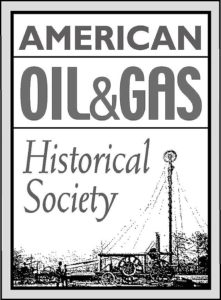by Bruce Wells | Aug 4, 2025 | This Week in Petroleum History
August 4, 1913 – Discovery of Oklahoma’s “Poor Man’s Field” –
The Crystal Oil Company completed its Wirt Franklin No. 1 well 20 miles northwest of Ardmore, Oklahoma. The wildcat well revealed the giant Healdton field, which became known as “the poor man’s field” because of its shallow depth and low cost of drilling. The area attracted many independent producers with limited financial backing.
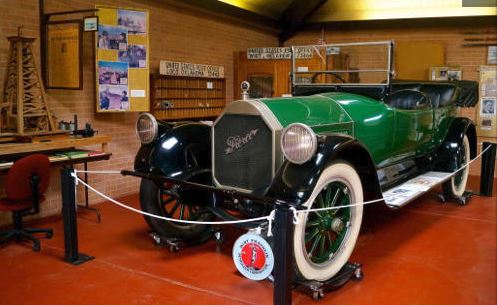
Healdton Oil Museum exhibits include the 1920 Pierce-Arrow owned by Wirt Franklin, who in 1929 founded a national trade association of independent oil and natural gas producers.
Another oil discovery in 1919 revealed the Hewitt field, which extended production 22 miles across Carter County. The Greater Healdton-Hewitt oilfield produced “an astounding 320,753,000 barrels of crude by the close of the first half of the 20th century,” noted Kenny Franks in his 1989 book, Ragtown: A History of the Greater Healdton-Hewitt Oil Field.
A young Erle P. Halliburton perfected a new method of cementing oil wells in “the poor man’s field” (see Halliburton and the Healdton Oilfield). Wirt Franklin of Ardmore became the first president of the then Tulsa-based Independent Petroleum Association of America (IPAA) in 1929.
August 4, 1977 – U.S. Department of Energy established
President Jimmy Carter signed the Department of Energy Organization Act, establishing the twelfth cabinet-level department by consolidating a dozen federal agencies and energy programs. The Act combined the Federal Energy Administration and the Energy Research and Development Administration, making the new Department of Energy (DOE) responsible for nuclear weapon programs and national labs. James Schlesinger was sworn in as the first Secretary of Energy.

August 5, 1882 – Rockefeller founds Standard Oil of New Jersey
Twelve years after launching Standard Oil Company of Ohio (bp America), John D. Rockefeller founded the Standard Oil Company of New Jersey (ExxonMobil) as a refining and marketing arm of the Standard Oil Trust, which would reorganize as Standard Oil Interests in 1892, two years after the Sherman Anti-Trust Act.
“Taking advantage of New Jersey laws that allowed corporations to own stock in other corporations, Standard Oil Company of New Jersey became a holding company that effectively replaced the Standard Oil Trust. In this capacity, it provided administrative coordination to Standard Oil Interests and held stock in forty-one other oil companies,” notes the American Heritage Center, University of Wyoming. The U.S. Supreme Court in 1911 ordered Standard Oil of New Jersey to separate from its subsidiaries.
August 7, 1933 – Permian Basin inspires “Alley Oop” Comic Strip
Although the comic strip “Alley Oop” began syndication with the Newspaper Enterprise Association, the caveman character began in Permian Basin oilfields of the 1920s. A small, West Texas oil town would proclaim itself the inspiration for cartoonist Victor Hamlin.
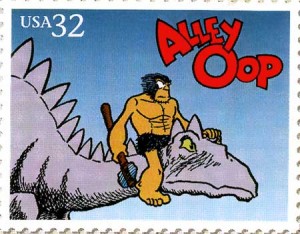
A 1995 stamp commemorated “Alley Oop” by Victor Hamlin, who once worked in oilfields at Yates, Texas.
Iraan (pronounced eye-rah-ann) began as a company town following the October 1926 discovery of the giant Yates oilfield. The town’s name combined the names of Ira and Ann Yates. As petroleum drilling in the Permian Basin boomed, future Alley Oop cartoonist Hamlin worked as an oil company cartographer. He developed a lifelong interest in geology and paleontology that helped inspire his popular Depression Era comic strip.
Learn more in Alley Oop’s Oil Roots.
August 7, 1953 – Outer Continental Shelf Lands Act generates Revenue
The Outer Continental Shelf Lands Act designated the Secretary of the Interior responsible for the administration of mineral exploration and development of America’s outer continental shelf. Forty-four Gulf of Mexico wells were already operating in 11 oilfields by 1949. As the offshore industry evolved in the 1950s, petroleum production became the second-largest revenue generator for the country, after income taxes.
Since 1982, the Interior Department has disbursed more than $387 billion in mineral leasing revenues. The Office of Natural Resources Revenue (ONRR ) in 2024 reported a disbursement of $16.45 billion (down from $18.24 billion in 2023) generated from energy production on federal and Tribal lands and federal offshore areas. Monthly disbursements came from the royalties, rents, and bonuses collected from energy and mineral companies operating on federal lands and waters.
August 7, 2004 – Death of a Famed “Hellfighter”
Famed oilfield well control expert and firefighter Paul “Red” Adair died at age 89 in Houston. The son of a blacksmith, Adair was born in 1915 in Houston. He served with a U.S. Army bomb disposal unit during World War II.

Famed oilfield firefighter Paul “Red” Adair of Houston, Texas, in 1964.
Adair had begun his oilfield career working for Myron Macy Kinley, who patented a technology for using charges of high explosives to snuff out well fires. Kinley, whose father had been an oil well shooter in California in the early 1900s, mentored many other firefighters, including Asger “Boots” Hansen and Edward “Coots” Mathews (Boots & Coots International Well Control).
After founding the Red Adair Company in 1959, Adair developed new techniques as his company extinguished over 2,000 well fires worldwide, onshore and offshore. The oilfield firefighter’s skills, dramatized in the 1968 film “Hellfighters,” were put to the test in 1991, when his company extinguished 117 well fires set in Kuwait by the retreating Iraqi army. Innovative oilfield firefighting technologies began as early as the 1860s.

August 9, 1921 – Reflection Seismography reveals Geological Structure
A team led by University of Oklahoma geophysicist John C. Karcher conducted the world’s first reflection seismograph measurement of a geologic formation, pioneering the use of reflection seismic technology. The geological section measurement followed limited tests in June and July at Oklahoma City. His work led to the discovery of many of the world’s largest oil and natural gas fields.
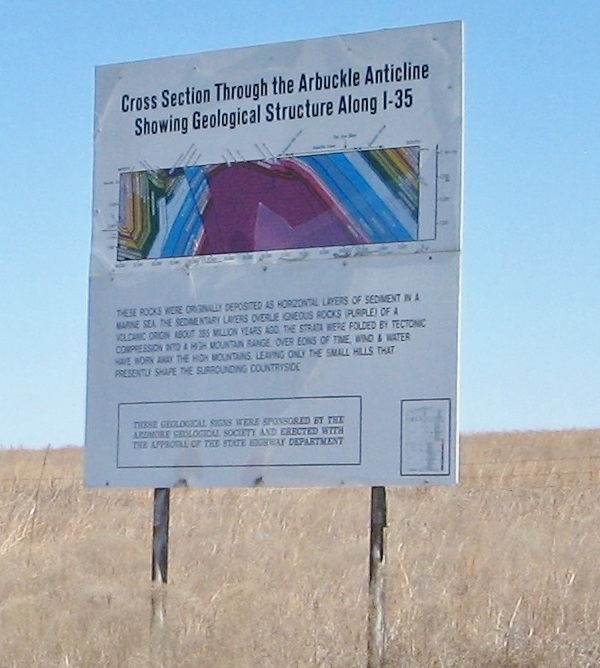
A roadside sign on I-35 south of Oklahoma City includes a geologic illustration of the Arbuckle Anticline. A nearby marker describes how using reflection seismography for oil exploration began here. Photo by Bruce Wells.
The new geophysical method recorded reflected seismic waves as they traveled through the earth, helping to define oil-bearing formations. The Arbuckle Mountains of Oklahoma were selected for testing the technique and new equipment, according to a roadside marker at the site south of Oklahoma City on I-35.
Learn More in Exploring Seismic Waves.
August 9, 1922 – Giant Oilfield revealed in Luling, Texas
After drilling six dry holes near Luling, Texas, the United North & South Oil Company completed its Rafael Rios No. 1 well. Company President Edgar B. Davis remained determined to find oil in the Austin chalk geologic formation. His perseverance paid off with an oilfield 12 miles long and two miles wide. The Luling field annually produced 11 million barrels of oil by 1924.
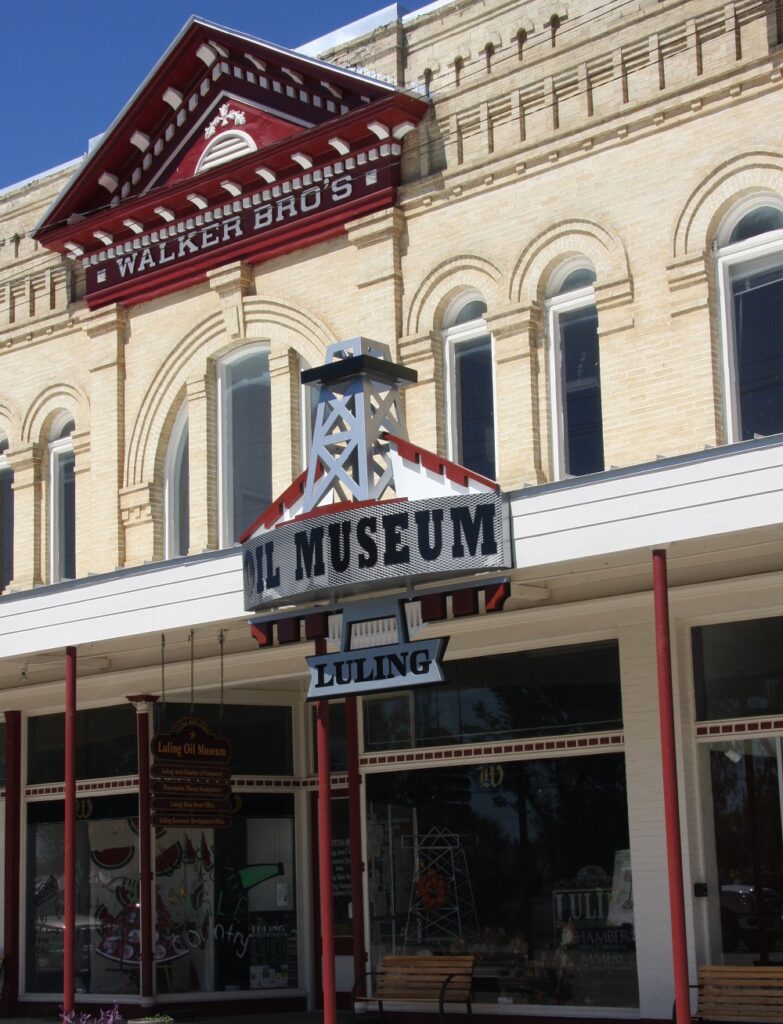
The Luling Oil Museum in central Texas is in a restored 1885 mercantile store near the 1922 oilfield a psychic claimed to help discover. Photo courtesy Luling Oil Museum.
On June 11, 1926, Davis sold his Luling leases to the Magnolia Petroleum Company for $12 million – the largest petroleum deal in Texas at the time. Success also produced local tales of Davis finding the Luling oilfield after consulting a psychic. Self-proclaimed clairvoyant Edgar Cayce reported he had helped Davis, but the psychic formed an exploration company that failed after drilling dry holes.
Learn more in Luling Oil Museum and Crudoleum.
On August 9, 1949 – Oil discovered in Western Nebraska
An oilfield discovery in western Nebraska ended decades of unsuccessful searching and helped start the state’s modern petroleum industry. The Marathon Oil Company Mary Egging No. 1 well, five miles southeast of the town of Gurley, produced 225 barrels of oil per day from a depth of 4,429 feet.
According to a nearby historical marker, the first exploratory well drilled in the area near Harrisburg failed in 1917. The success in western Nebraska came nine years after the first Nebraska oil well was completed in 1940 in the southeastern corner of the state.

Marathon Oil in May 2024 announced it was being acquired by ConocoPhillips in an all-stock transaction valued at $22.5 billion.
August 10, 1909 – Hughes patents Two-Cone Drill Bit
“Fishtail” drill bits became obsolete after Howard Hughes Sr. of Houston, Texas, patented the dual-cone roller bit with two rotating cones. By pulverizing hard rock, his bit led to faster and deeper rotary drilling. A few months before receiving the 1909 drill patent, Hughes and Walter Sharp established the manufacturing company Sharp-Hughes Tool (see Carl Baker and Howard Hughes).
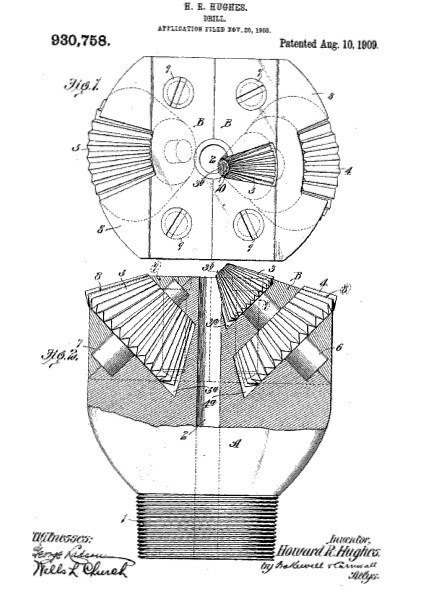
Howard Hughes Sr. of Houston, Texas, received a 1909 patent for “roller drills such as are used for drilling holes in earth and rock.”
“Instead of scraping the rock, as does the fishtail bit, the Hughes bit, with its two conical cutters, took a different engineering approach,” reported the American Society of Mechanical Engineers (ASME). “By chipping, crushing, and powdering hard rock formations, the Hughes Two-Cone Drill Bit could reach vast amounts of oil in reservoirs thousands of feet below the surface. This new drilling technology would revolutionize the industry.”
In 1933, Hughes engineers invented the modern tri-cone bit; Frank and George Christensen developed the earliest diamond bit in 1941; and tungsten-carbide bits arrived in the early 1950s. By the 1970s, synthetic diamonds evolved into the polycrystalline diamond compact bit. ASME in 2009 designated the Hughes two-cone drill bit a Historic Mechanical Engineering Landmark (no. 246).
Learn more in Making Hole – Drilling Technology.
_______________________
Recommended Reading: Ragtown: A History of the Greater Healdton-Hewitt Oil Field (1989); The New Map: Energy, Climate, and the Clash of Nations (1999); Titan: The Life of John D. Rockefeller, Sr.
(1989); The New Map: Energy, Climate, and the Clash of Nations (1999); Titan: The Life of John D. Rockefeller, Sr. (2004); Yates: A family, A Company, and Some Cornfield Geology
(2004); Yates: A family, A Company, and Some Cornfield Geology (2000); An American Hero: The Red Adair Story
(2000); An American Hero: The Red Adair Story (1990); Oil And Gas In Oklahoma: Petroleum Geology In Oklahoma
(1990); Oil And Gas In Oklahoma: Petroleum Geology In Oklahoma (2013); Texas Art and a Wildcatter’s Dream: Edgar B. Davis and the San Antonio Art League
(2013); Texas Art and a Wildcatter’s Dream: Edgar B. Davis and the San Antonio Art League (1998); Drilling Technology in Nontechnical Language
(1998); Drilling Technology in Nontechnical Language (2012). Your Amazon purchase benefits the American Oil & Gas Historical Society. As an Amazon Associate, AOGHS earns a commission from qualifying purchases.
(2012). Your Amazon purchase benefits the American Oil & Gas Historical Society. As an Amazon Associate, AOGHS earns a commission from qualifying purchases.
_______________________
The American Oil & Gas Historical Society (AOGHS) preserves U.S. petroleum history. Please become an annual AOGHS supporter and help maintain this energy education website and expand historical research. For more information, contact bawells@aoghs.org. © 2025 Bruce A. Wells. All rights reserved.
by Bruce Wells | Aug 1, 2025 | Petroleum Technology
A flammable workplace brings danger everywhere.
Whether ignited by accident, natural phenomena, or acts of war, oilfield fires have challenged the petroleum industry since the earliest wells. Catastrophic fires — and technologies needed to fight them — began with the first U.S. well, completed on August 27, 1859, at Oil Creek in northwestern Pennsylvania.
Just six weeks after his discovery, Edwin L. Drake’s well caught fire when driller William “Uncle Billy” Smith inspected the well with an open lamp, igniting seeping natural gas. Flames consumed the cable-tool derrick, engine-pump house, stored oil, and Smith’s nearby shack.
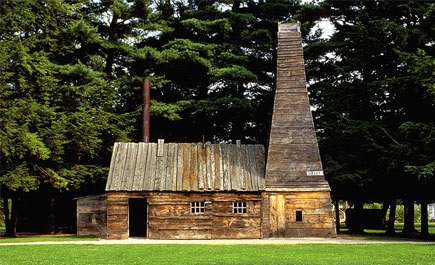
Drake Well Museum exhibits at Oil Creek in Titusville, Pennsylvania, include a replica of the cable-tool derrick and engine house that drilled the first U.S. well in 1859.
Today, visitors to the Drake Well Museum at Titusville tour the latest reconstructed cable-tool derrick and its engine house along Oil Creek, where the former railroad conductor found oil at a depth of 69.5 feet. He revealed a geologic formation later called the Venango sandstone.
Another Drake Well Museum exhibit preserves the Titusville Fire Department’s coal-fired steam pumper (see Oilfield Photographer John Mather). As the new U.S. petroleum industry learned from hard experience, firefighting technologies evolved in northwestern Pennsylvania’s “Valley that Changed the World.”
Hard Lessons
In 1861, an explosion and fire at Henry Rouse’s gushing oil well made national news when he was killed along with 18 workers and onlookers (see Rouseville 1861 Oil Well Fire). In 1977, the Smithsonian American Art Museum acquired landscape artist James Hamilton’s “Burning Oil Well at Night, near Rouseville, Pennsylvania,” painted soon after the fire.
The dangerous operating environment of a cable-tool rig included a spinning bull wheel, a rising and falling heavy wooden beam, a steam boiler, and crowded spaces.

The pounding iron drill bit frequently needed to be withdrawn and hammered sharp using a small, but red-hot forge, often set up just feet from the wellbore.
Lighting striking derricks and oilfield tank farms also would prove challenging.
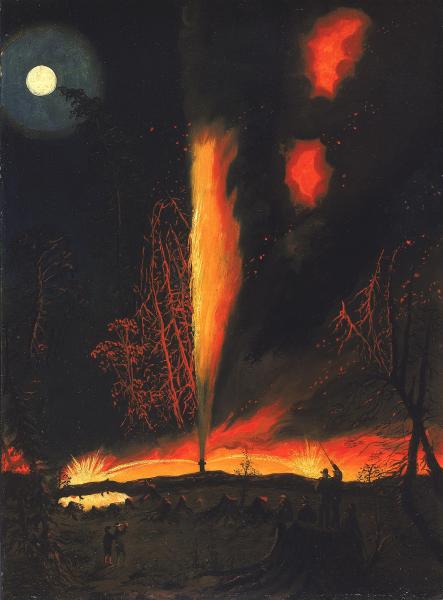
Preserved by the Smithsonian, “Burning Oil Well at Night, near Rouseville, Pennsylvania,” circa 1861, an oil painting by James Hamilton, Smithsonian American Art Museum, Washington, DC.
Late 19th-century oilfield fire prevention remained rudimentary as exploration moved westward. Safety lamps like one with two spouts, popularly known as the “Yellow Dog” lantern, were not particularly safe. The rapidly growing petroleum industry needed new technologies for preventing fires or putting them out.
As drilling experience grew, refineries responded to skyrocketing public demand for the lamp fuel kerosene. Production from new oilfields in Texas, Kansas, and Oklahoma led to construction of safer storage facilities, but advances in drilling deeper wells brought fresh challenges (see Ending Oil Gushers – BOP).
Firefighting with Cannons
Especially in early oilfields, working in such a flammable workplace could bring danger from everywhere — including the sky. Lightning strikes on wooden storage tanks created flaming cauldrons.
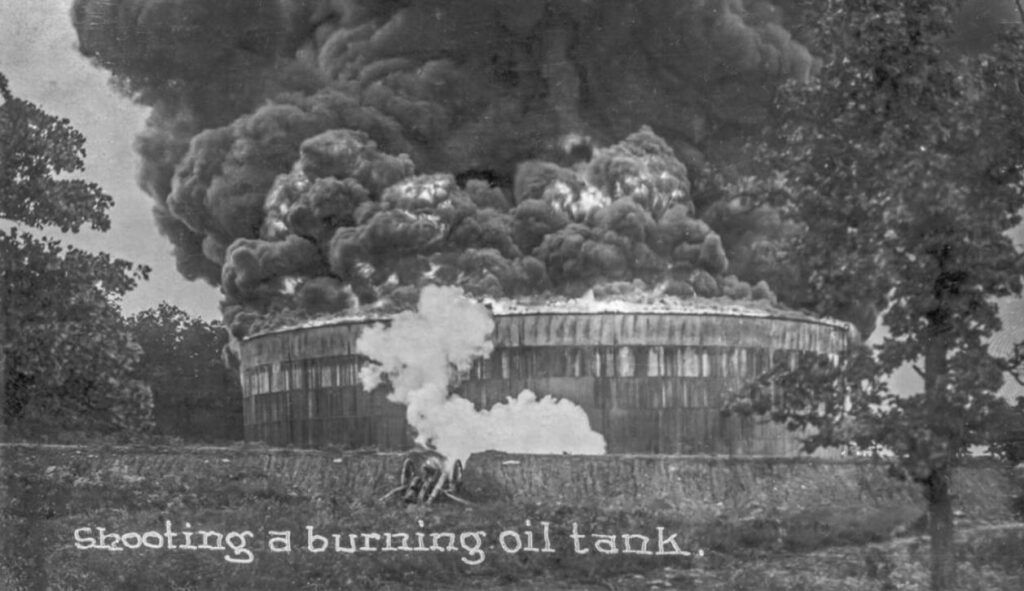
A circa 1915 photo of a cannon — possibly a “Model 1819,” according to The Artilleryman Magazine (Fall 2019, vol. 40, no. 4) — firing solid shot in an attempt to create a hole to drain the burning oil tank. “No one appears to be near the gun, so it may have been fired using fuse or electrically.” Photo courtesy Oklahoma Historical Society.
In the rush to exploit early oilfields, wooden derricks crowded an oil-soaked landscape, leaving workers — and nearby towns — dangerously exposed to an accidental conflagration. Many oil patch community oil museums have retained examples of early smooth-bore cannon used to fight fires.
A Civil-War era field cannon exhibit in Corsicana, Texas, tells the story of a cannon from the Magnolia Petroleum Company tank farm. “It was used to shoot a hole in the bottom of the cypress tanks if lightning struck,” a plaque notes. “The oil would drain into a pit around the tanks and be pumped away.”
Learn more in Oilfield Artillery fights Fires.

Oilfield firefighting using cannons has continued into the 21st century. In May 2020, a well operated by the Irkutsk Oil Company in Russia’s Siberian region ignited a geyser of flaming oil and natural gas. When efforts to control the blowout failed, the Russian Defense Ministry flew in a 1970s anti-tank gun and its Hungarian crew.
From about 200 yards away, the Hungarian artillerymen (Covid-19 masked) repeatedly fired their 100-millimeter, smooth-bore Rapira MT-12 gun at blazing oilfield equipment, “breaking it from the well and allowing crews to seal the well,” according to the Russian Defense Ministry.
In addition to using cannons to fire well fires, other techniques have included smothering them using cranes to lower iron metal caps (see Kansas Gas Well Fire) or detonating an explosive from above to rob the flames of air. Using a wind machine must count among the more unusual methods.
Firefighting with Wind
In 1929, about 400 volunteers took on a raging oilfield fire that had destroyed seven derricks and two oil well “heavy producers” at Santa Fe Springs, California. “Roaring Flames Turn Black Gold To Smoke,” proclaimed a Los Angeles Times headline on June 12.
The Santa Fe Springs Hathaway Ranch and Oil Museum, “a museum of five generations of Hathaway family and Southern California history,” has preserved rare motion picture clips of a propeller-driven “Wind-making Machine” in action — although the wind proved no match for the flames.
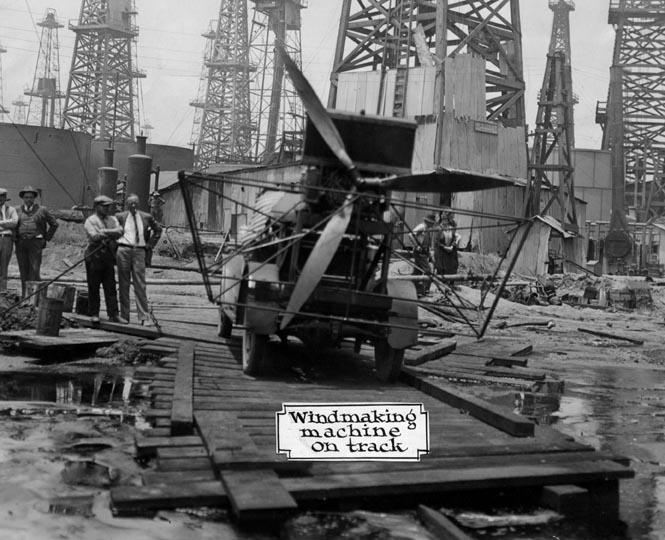
“The machine that made the wind that conquered a fire in a Santa Fe Springs oilfield on June 15, 1929,” used a three-bladed airplane propeller and a powerful motor to blow heat away from the men at work fighting the fire. “A track of boards was built for the machine over a lake of oil, mud and water in the ‘hot zone’ of the big fire.” — Hathaway Ranch and Oil Museum, Santa Fe Springs, California.
The fire depicted in the silent film is intense, “so firefighting equipment is appropriately distant from the well head, including the wind machine,” explained museum Curator of Media Archives Terry Hathaway.
“It looks like its use is more or less limited to blowing hot air, smoke and steam (from firefighting water hoses) away from the workers and toward the fire,” he added.

Hathaway explained that the wind machine on the back of a truck probably had no direct influence on the fire itself, due to distance and the ferocity of the high-pressure well blowout, “but it apparently may have made things more tenable for the firefighters by keeping them relatively cool and smoke free.”
A modern version of the 1929 wind-making machine returned in 1991, after Saddam Hussein’s retreating Iraqi army set hundreds of wells ablaze in Kuwait oilfields. Firefighting technologies by then had evolved into using jet engines. MB Drilling Company of Szolnok, Hungary, sent a three-man team with “Big Wind,” a modern version of the 1929 wind-making machine.
Instead of a piston-driven propeller on a vintage truck bed, twin MIG-21 turbojets were mounted in place of the turret on a World War II Soviet T-34 tank. The jet engines generated 700 mph of thrust, which blasted hundreds of gallons of water per second into the flames.
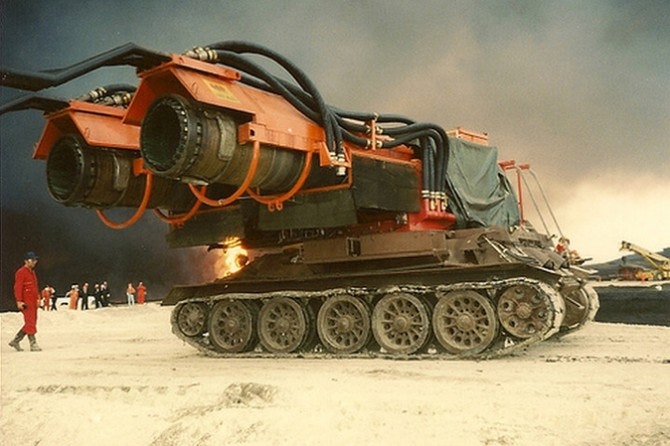
Image from Romanian video of 1991 Kuwaiti oilfields: “Twin MIG-21 turbojets mounted on a World War II era Soviet T-34 tank dubbed ‘Big Wind’ generated 700 mph thrust blasting hundreds of gallons of water per second into the fire.”
The Hungarian team members put out their assigned fires and recapped nine wells in 43 days, according to a 2001 Car and Driver article, “Stilling the Fires of War.”
“Hell Fighters”
Many firefighting teams went to Kuwait following the Persian Gulf War, including Paul “Red” Adair, whose dramatic oilfield feats had been popularized in the 1968 movie “Hellfighters.” Adair and his team extinguished 117 Kuwaiti oil well fires by robbing the flames of oxygen using explosives.
As the Hungarian crew chief of “Big Wind” observed at the time, “Would you really want to walk up to a 2,000-degree flame through burning heat and oil rain carrying explosives?”
A century earlier, Karl T. Kinley did just that. Kinley, a California oil well “shooter” (see Shooters — A History of Fracking) during the early 1900s, learned from first-hand experience that a dynamite explosion could “blow out” a wellhead fire. Kinley’s son, Myron Macy Kinley, established the oilfield service business M.M. Kinley Company after learning from his father’s highly dangerous experiments.

Readers Digest in 1953 declared Myron M. Kinley “the unrivaled world-champion fighter of oil fires.” A TIME article described him as “the indispensable man of the oil industry.”
But with the chance of terrible injuries or death ever present, firefighting success was not without cost. Kinley’s brother Floyd was killed by falling rig debris in 1938 as they fought a runaway well fire near Goliad, Texas.
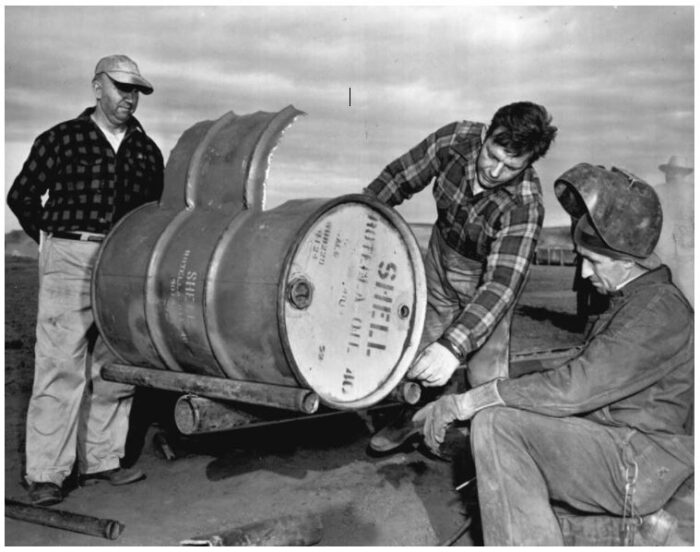
Myron M. Kinley (at left), Paul “Red Adair (center), and a welder examine a nitroglycerin bomb barrel. Myron Kinley has been called the grandfather of modern oil well fire fighting, according to the Oklahoma Historical Society. Photo by A.Y. Owen courtesy OHS Oklahoma Publishing Company Photography Collection.
Kinley, a mentor of “Red” Adair, developed technologies at M.M. Kinley Company that inspired other firefighting experts, including Joe R. Bowden Sr., who founded Wild Well Control in 1975 to provide emergency response, safety training, and relief well engineering.
After they had worked for the Red Adair Service and Marine Company, Asger “Boots” Hansen and “Coots” Mathews opened an office in Houston in 1978 for what could become Boots & Coots International Well Control (today a Halliburton Company).
Other oilfield pioneers include Cudd Pressure Control — today, Cudd Well Control, founded by Bobby Joe Cudd, another pioneer of emergency well control techniques. Cudd established his Woodward, Oklahoma-based company in 1977 with eight employees and a “hydraulic snubbing unit.”
Adair had joined Myron Kinley’s California oilfield service company after serving with a U.S. Army bomb disposal unit during World War II. After starting his own company in 1959, “Red” improved firefighting technologies, developing new tools, equipment, and techniques for “wild well” control.
Adair was 75 years old when he successfully tamed roaring fires in Kuwait’s scorched oilfields. As early as 1962, his Red Adair Company had “put out a Libyan oil well fire that had burned so brightly that astronaut John Glenn could see it from space,” the Los Angeles Times reported.
USSR Firefighting Nukes
Between 1966 and 1981, the Union of Soviet Socialist Republics snuffed out runaway fires at natural gas wells using subsurface nuclear detonations. The experiments, part of the broader “Program No. 7 – Nuclear Explosions for the National Economy,” imitated a U.S. initiative, “Plowshare,” seeking peaceful uses of nuclear bombs (see Project Gasbuggy tests Nuclear “Fracking”).
According to the Lawrence Livermore National Laboratory, USSR scientists code-named five secret attempts: Urta-Bulak, Pamuk, Crater, Fakel, and Pyrite.
The first experimental detonation, Urta-Bulak in 1966, came after three years and failed conventional attempts to extinguish a blazing natural gas well in Southern Uzbekistan. Scientists positioned a special 30-kiloton package within 300 feet of the borehole by slant drilling.
Detonated in clay strata at a depth of 4,921 feet, the nuclear explosion’s shock wave sealed the well within 23 seconds, staunching the daily waste of 423 million cubic feet of natural gas, reported Russian television.

Video image showing a USSR nuclear device being lowered into well for a detonation shockwave to extinguish a runaway oilfield fire. A Russian newspaper reported a 1966 nuclear blast used to put out a natural gas well fire in Uzbekistan.
In 1968, the Pamuk well explosion used a larger, 47-kiloton nuclear device that measured 9.5 inches by 10 feet. Two years of uncontrolled natural gas and a heavily saturated surrounding landscape yielded to the nuclear detonation at a depth of 8,000 feet. The runaway gas well died out seven days later.
Twice in 1972, USSR scientists used lower-yield detonations to extinguish massive fires. The smallest of the nuclear firefighting devices (3.8 kiloton) on July 7 squelched a runaway gas well fire in Ukraine, about 12 miles north of Krasnograd.
The USSR program’s only recorded failure came in 1981 with the last Soviet use of firefighting nukes. On May 5, a nuclear device failed to shut down a 56 million cubic feet per day out-of-control natural gas well. The code-named Pyrite device had been positioned proximate to the well at a depth of 4,957 feet.

The 37.6-kiloton detonation in a sandstone-clay formation failed to seal the gas well, according to the USSR Ministry of Defense, which provided little more information.
By the 1950s, America was considering how to use nuclear weapons for constructive purposes — “Atoms for Peace.” In December 1961, the Plowshare Program began examining the feasibility of various projects, including the Project Gasbuggy tests to improve natural gas production. Those tests worked, but yielded radioactive gas.
Neither the Project Plowshare nor the Soviet Union’s Program No. 7 produced desirable results. With or without nukes, oilfield work then and now remains among the most dangerous jobs in the world. Safety and prevention methods have improved along with the technologies since the industry’s earliest wells in northwestern Pennsylvania.
_______________________
Recommended Reading: The Birth of the Oil Industry (1936); Trek of the Oil Finders: A History of Exploration for Petroleum (1975); The Prize: The Epic Quest for Oil, Money & Power (1991); Myth, Legend, Reality: Edwin Laurentine Drake and the Early Oil Industry (2009). Your Amazon purchase benefits the American Oil & Gas Historical Society. As an Amazon Associate, AOGHS earns a commission from qualifying purchases.
(2009). Your Amazon purchase benefits the American Oil & Gas Historical Society. As an Amazon Associate, AOGHS earns a commission from qualifying purchases.
_______________________
The American Oil & Gas Historical Society preserves U.S. petroleum history. Please become an annual supporter and help maintain this energy education website and expand historical research. For more information, contact bawells@aoghs.org. Copyright © 2025 Bruce A. Wells.
Citation Information – Article Title: “Exploring Oilfield Firefighting Technologies.” Authors: B.A. Wells and K.L. Wells. Website Name: American Oil & Gas Historical Society. URL: https://aoghs.org/technology/oilfield-firefighting-technologies. Last Updated: August 1, 2025. Original Published Date: January 31, 2022.





(1989); The New Map: Energy, Climate, and the Clash of Nations (1999); Titan: The Life of John D. Rockefeller, Sr.
(2004); Yates: A family, A Company, and Some Cornfield Geology
(2000); An American Hero: The Red Adair Story
(1990); Oil And Gas In Oklahoma: Petroleum Geology In Oklahoma
(2013); Texas Art and a Wildcatter’s Dream: Edgar B. Davis and the San Antonio Art League
(1998); Drilling Technology in Nontechnical Language
(2012). Your Amazon purchase benefits the American Oil & Gas Historical Society. As an Amazon Associate, AOGHS earns a commission from qualifying purchases.











